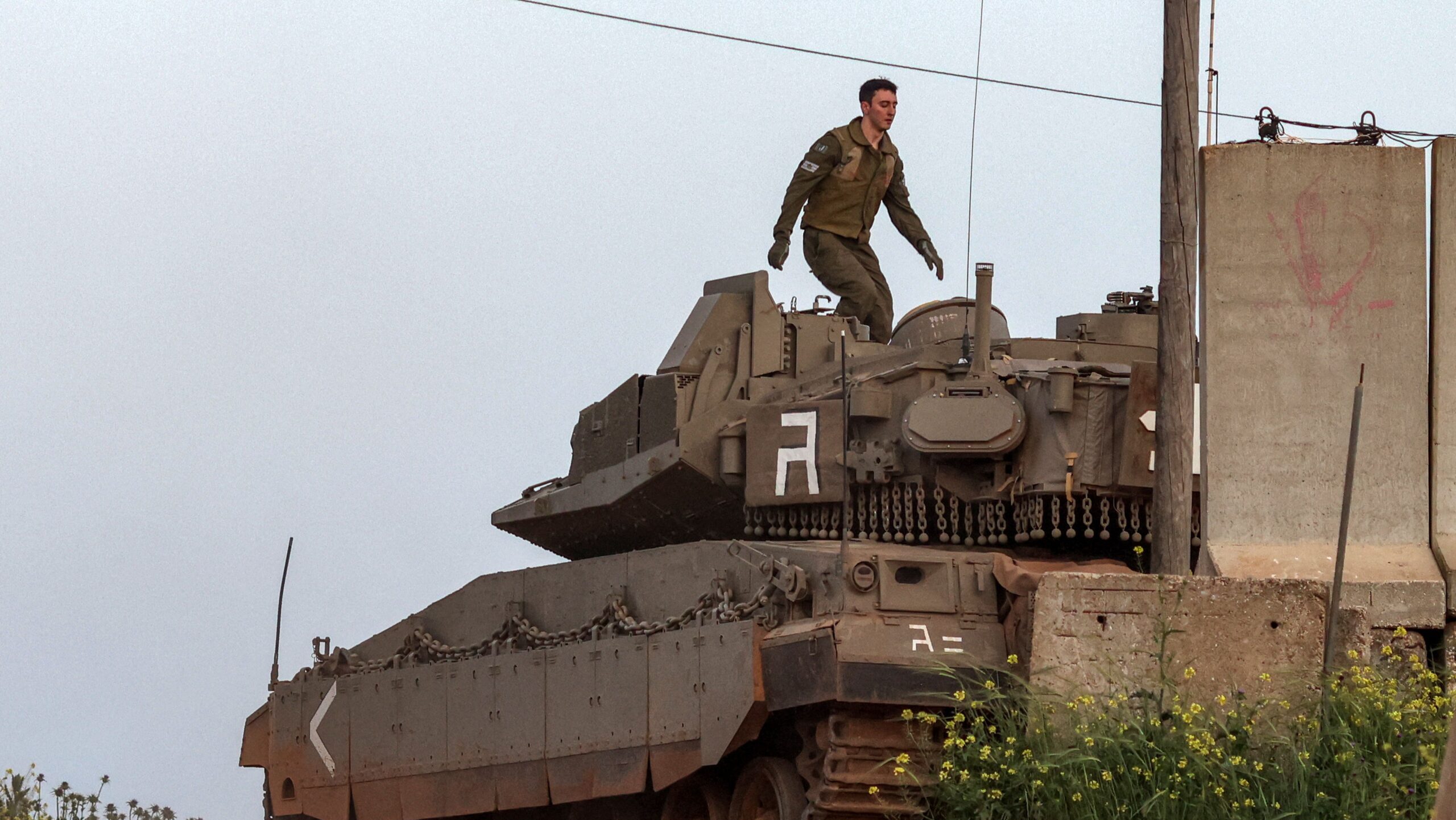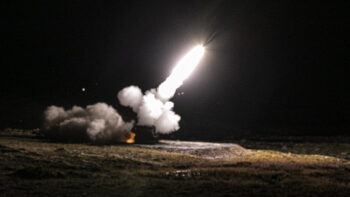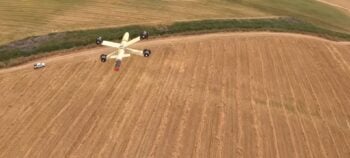
An Israeli soldier walks on the turret of a Merkava Mark IV battle tank stationed at a position along Israel’s northern border with Lebanon in the vicinity of the village of Shtula on April 6, 2023. (OREN ZIV/AFP via Getty Images)
JERSUALEM — The Israel Defense Forces are expanding the number of regular army tank companies in each battalion of the armored corps, a direct result of lessons learned from six months of war in Gaza — and one taken with an eye towards future conflicts.
The IDF’s decision to increase the number of tank companies manned by regular army soldiers, as opposed to reservists, reverses a decision made more than a decade ago to reduce the number of active tank companies, and is one of several new units and reorganizations the IDF has embarked on due to the ongoing war.
It also may seem counter-intuitive on its face, as tanks are generally viewed as ineffective for urban warfare. But while most photos of Gaza show destroyed buildings and high-rises, the region features quite a bit of open area outside of Gaza City proper, which is where Israeli tanks have been largely operational.
Capt. Amitai, a company commander in the 82nd battalion of the 7th armored brigade who spoke to Breaking Defense last week about the new initiative, said that armored vehicles have played a critical role in the conflict.
In addition to the 7th armored, the IDF also operates the 188th and 401st regular armored brigades. Each has seen service in Gaza. The armored brigades played a key role in the ground offensive which began on Oct. 7, with tanks rolling across Gaza and down the coastline to link up and cut off Gaza city from central and southern Gaza.
RELATED: Tanks may face new threats on the modern battlefield, but they’re already adapting
Amitai — whose full name was not provided for security reasons — praised the tanks’ role as providing “protection and firepower and the ability to move quickly in difficult terrain” for infantry and engineers who then are involved in the more urban elements of the conflict. He noted that tanks have proven themselves in this conflict, especially spotlighting the Trophy Active Protection system on the IDF’s Merkava IV main battle tanks.
“It gives a lot of confidence to know you are protected by such a system, I saw it with my own eyes,” he says, describing how his deputy battalion commander’s tank was targeted by two missiles. “We were in an ambush and it intercepted two missiles and destroyed a squad of three terrorists in seconds.”
Jonathan Spyer, a researcher at the Jerusalem Institute for Strategy and Security, notes that “as part of combined arms teams, armored forces have played a central and vital role in the fighting in Gaza.” He told Breaking Defense that the decision to “rebuild companies which had been disbanded forms part of the general increase in the defense budget expected to follow the war.”
“It may also reflect an understanding that the IDF of the coming period needs to be equipped to fight semi-regular and regular forces, bringing different needs and requiring different resources to those needed for counter terror and counter insurgency operations,” says Spyer.
Moving On From Reserve Reliance
According to Amitai, IDF tank brigades consist of battalions that have two companies of tanks staffed by regular army conscript soldiers, plus a third company of reservists. Now the IDF is expanding the tank battalions, so they will each have a third regular army tank company. (Tank companies usually have 12 tanks, but numbers can vary, and the IDF doesn’t provide exact figures.) The reservists, now freed from tank duty, will be used in another capacity.
Building up the companies isn’t an overnight process; three companies are being trained now, but that training can take up to nine months, Amitai said. In other words, this process is going to go on for a bit.
However, there doesn’t seem to be concern about where to find the bodies. Amitai claimed that the recent conflict has showed the public how “amazing” the tanks can be in the modern battlefield, and stated there are 30 percent more recruits to the tank brigades than in the past. That would represent the largest recruitment to the armored corps in “many years,” the Israeli website Mako noted.
RELATED: Israel unveils new ‘5th generation’, ‘lightning’ version of Merkava tank
And that recruitment is going to be important, because the IDF’s long-term goal here is to not rely on reservists for so much of its tank force. Israel pressed into service up to 300,000 reservists in the wake of the Oct. 7 attack by Hamas, which is both a testament to its ability to flow manpower and a sign that the regular military was not equipped to sustain a long-term conflict. The new tank units reflect the need to send reservist soldiers home.
Ultimately, expanding the number of active-duty, full-time tank operators isn’t just about the Gaza conflict. It’s about being prepared for another conflict down the road, whether it be in Lebanon, Syria or in Iran.
Having three regular army tank companies in each battalion, as opposed to two, means the units can stay in the field longer. However, don’t expect to see IDF buyers searching desperately for new tanks to procure: The expansion of the armored corps regular tank units isn’t expanding the overall number of tanks, but rather putting tanks that were used by reservists back into active duty.
The IDF has also opened a similar company in the 52nd battalion of the 401st brigade and 71st battalion of the 188th brigade. The shift is one of several that has happened since the Oct. 7 war began. The IDF established a new Mountain Brigade and also a new Hermes 900 drone unit, called the 147th squadron. The IDF is also expected to return to service more combat helicopters and acquire more F-35s and F-15s as part of a multi-year procurement program.
Amitai was tasked with creating this third company within the 82nd battalion, the first battalion to create this new company. Like the rest of Israel’s armored units, they use the Merkava IV main battle tank. The soldiers he has been training for the unit have all trained together as a group, something unique in the IDF, where tank operators may not have worked together prior to unit assignments. “We established the company three months ago and then had one and a half months of training, and spent the last weeks in Khan Younis,” in southern Gaza, he said.
The unit was withdrawn from Khan Younis in early April, along with the 98th division it had been operating under. Amitai said operations alongside the 98th, which includes the IDF’s elite Commando Brigade, went as expected. The 7th armored is usually part of the IDF’s 36th division, under which it operated when the war began. In the past it has trained with Golani infantry and combat engineers for potential conflict in northern Israel. In training the new battalion, Amitai described the challenges new tank crews face. They spent “a lot of time in the tank under pressure and under heat. Not seeing home for a while.”
Aloha: Fixes ongoing, then Army’s new watercraft prototype is Hawaii bound for testing
“Everything that we can knock off that list we will do in the archipelago…because that allows us to do the tests in the environment that the vessel will operate in ultimately,” said Maj. Gen. Jered Helwig.


























